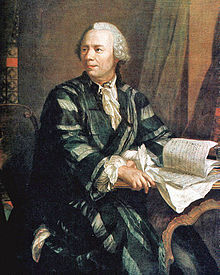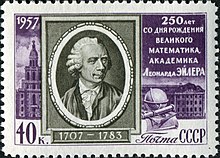Le
From Wikipedia, the free encyclopedia
"Euler" redirects here. For other uses, see Euler (disambiguation).
| Leonhard Euler | |
|---|---|
 Portrait by Johann Georg Brucker (1756) |
|
| Born | 15 April 1707 Basel, Switzerland |
| Died | 18 September 1783 (aged 76) [OS: 7 September 1783] Saint Petersburg, Russian Empire |
| Residence | Kingdom of Prussia, Russian Empire Switzerland |
| Nationality | Swiss |
| Fields | Mathematics and physics |
| Institutions | Imperial Russian Academy of Sciences Berlin Academy |
| Alma mater | University of Basel |
| Doctoral advisor | Johann Bernoulli |
| Doctoral students | Nicolas Fuss Johann Hennert Joseph Louis Lagrange Stepan Rumovsky |
| Known for | See full list |
| Signature |
|
|
Notes
He is the father of the mathematician Johann Euler He is listed by an academic genealogy[citation needed] as the equivalent to the doctoral advisor of Joseph Louis Lagrange. |
|
Contents |
Life
Early years

Old Swiss 10 Franc banknote honoring Euler
St. Petersburg
Around this time Johann Bernoulli's two sons, Daniel and Nicolas, were working at the Imperial Russian Academy of Sciences in St Petersburg. On July 10, 1726, Nicolas died of appendicitis after spending a year in Russia, and when Daniel assumed his brother's position in the mathematics/physics division, he recommended that the post in physiology that he had vacated be filled by his friend Euler. In November 1726 Euler eagerly accepted the offer, but delayed making the trip to St Petersburg while he unsuccessfully applied for a physics professorship at the University of Basel.[8]
1957 stamp of the former Soviet Union
commemorating the 250th birthday of Euler. The text says: 250 years
from the birth of the great mathematician, academician Leonhard Euler.
The Academy at St. Petersburg, established by Peter the Great, was intended to improve education in Russia and to close the scientific gap with Western Europe. As a result, it was made especially attractive to foreign scholars like Euler. The academy possessed ample financial resources and a comprehensive library drawn from the private libraries of Peter himself and of the nobility. Very few students were enrolled in the academy in order to lessen the faculty's teaching burden, and the academy emphasized research and offered to its faculty both the time and the freedom to pursue scientific questions.[7]
The Academy's benefactress, Catherine I, who had continued the progressive policies of her late husband, died on the day of Euler's arrival. The Russian nobility then gained power upon the ascension of the twelve-year-old Peter II. The nobility were suspicious of the academy's foreign scientists, and thus cut funding and caused other difficulties for Euler and his colleagues.
Conditions improved slightly upon the death of Peter II, and Euler swiftly rose through the ranks in the academy and was made professor of physics in 1731. Two years later, Daniel Bernoulli, who was fed up with the censorship and hostility he faced at St. Petersburg, left for Basel. Euler succeeded him as the head of the mathematics department.[10]
On 7 January 1734, he married Katharina Gsell (1707–1773), a daughter of Georg Gsell, a painter from the Academy Gymnasium.[11] The young couple bought a house by the Neva River. Of their thirteen children, only five survived childhood.[12]
Berlin

Stamp of the former German Democratic Republic honoring Euler on the 200th anniversary of his death. Across the centre it shows his polyhedral formula, nowadays written as v − e + f = 2.
In addition, Euler was asked to tutor the Princess of Anhalt-Dessau, Frederick's niece. Euler wrote over 200 letters to her in the early 1760s, which were later compiled into a best-selling volume entitled Letters of Euler on different Subjects in Natural Philosophy Addressed to a German Princess. This work contained Euler's exposition on various subjects pertaining to physics and mathematics, as well as offering valuable insights into Euler's personality and religious beliefs. This book became more widely read than any of his mathematical works, and it was published across Europe and in the United States. The popularity of the 'Letters' testifies to Euler's ability to communicate scientific matters effectively to a lay audience, a rare ability for a dedicated research scientist.[14]
Despite Euler's immense contribution to the Academy's prestige, he was eventually forced to leave Berlin. This was partly because of a conflict of personality with Frederick, who came to regard Euler as unsophisticated, especially in comparison to the circle of philosophers the German king brought to the Academy. Voltaire was among those in Frederick's employ, and the Frenchman enjoyed a prominent position in the king's social circle. Euler, a simple religious man and a hard worker, was very conventional in his beliefs and tastes. He was in many ways the direct opposite of Voltaire. Euler had limited training in rhetoric, and tended to debate matters that he knew little about, making him a frequent target of Voltaire's wit.[14] Frederick also expressed disappointment with Euler's practical engineering abilities:
I wanted to have a water jet in my garden: Euler calculated the force of the wheels necessary to raise the water to a reservoir, from where it should fall back through channels, finally spurting out in Sanssouci. My mill was carried out geometrically and could not raise a mouthful of water closer than fifty paces to the reservoir. Vanity of vanities! Vanity of geometry![15]

A 1753 portrait by Emanuel Handmann. This portrayal suggests problems of the right eyelid, and possible strabismus. The left eye, which here appears healthy, was later affected by a cataract.[16]
Eyesight deterioration
Euler's eyesight worsened throughout his mathematical career. Three years after suffering a near-fatal fever in 1735 he became nearly blind in his right eye, but Euler rather blamed his condition on the painstaking work on cartography he performed for the St. Petersburg Academy. Euler's sight in that eye worsened throughout his stay in Germany, so much so that Frederick referred to him as "Cyclops". Euler later suffered a cataract in his good left eye, rendering him almost totally blind a few weeks after its discovery in 1766. Even so, his condition appeared to have little effect on his productivity, as he compensated for it with his mental calculation skills and photographic memory. For example, Euler could repeat the Aeneid of Virgil from beginning to end without hesitation, and for every page in the edition he could indicate which line was the first and which the last. With the aid of his scribes, Euler's productivity on many areas of study actually increased. He produced on average one mathematical paper every week in the year 1775.[3]Return to Russia
The situation in Russia had improved greatly since the accession to the throne of Catherine the Great, and in 1766 Euler accepted an invitation to return to the St. Petersburg Academy and spent the rest of his life in Russia. His second stay in the country was marred by tragedy. A fire in St. Petersburg in 1771 cost him his home, and almost his life. In 1773, he lost his wife Katharina after 40 years of marriage. Three years after his wife's death, Euler married her half-sister, Salome Abigail Gsell (1723–1794).[17] This marriage lasted until his death.In St. Petersburg on 18 September 1783, after a lunch with his family, during a conversation with a fellow academician Anders Johan Lexell about the newly discovered Uranus and its orbit, Euler suffered a brain hemorrhage and died a few hours later.[18] A short obituary for the Russian Academy of Sciences was written by Jacob von Staehlin-Storcksburg and a more detailed eulogy[19] was written and delivered at a memorial meeting by Russian mathematician Nicolas Fuss, one of Euler's disciples. In the eulogy written for the French Academy by the French mathematician and philosopher Marquis de Condorcet, he commented,
He was buried next to Katharina at the Smolensk Lutheran Cemetery on Vasilievsky Island. In 1785, the Russian Academy of Sciences put a marble bust of Leonhard Euler on a pedestal next to the Director's seat and, in 1837, placed a headstone on Euler's grave. To commemorate the 250th anniversary of Euler's birth, the headstone was moved in 1956, together with his remains, to the 18th-century necropolis at the Alexander Nevsky Monastery.[21]...il cessa de calculer et de vivre—... he ceased to calculate and to live.[20]

Euler's grave at the Alexander Nevsky Monastery
Contributions to mathematics and physics
|
Euler is the only mathematician to have two numbers named after him: the immensely important Euler's Number in calculus, e, approximately equal to 2.71828, and the Euler-Mascheroni Constant γ (gamma) sometimes referred to as just "Euler's constant", approximately equal to 0.57721. It is not known whether γ is rational or irrational.[22]
Mathematical notation
Euler introduced and popularized several notational conventions through his numerous and widely circulated textbooks. Most notably, he introduced the concept of a function[2] and was the first to write f(x) to denote the function f applied to the argument x. He also introduced the modern notation for the trigonometric functions, the letter e for the base of the natural logarithm (now also known as Euler's number), the Greek letter Σ for summations and the letter i to denote the imaginary unit.[23] The use of the Greek letter π to denote the ratio of a circle's circumference to its diameter was also popularized by Euler, although it did not originate with him.[24]Analysis
The development of infinitesimal calculus was at the forefront of 18th Century mathematical research, and the Bernoullis—family friends of Euler — were responsible for much of the early progress in the field. Thanks to their influence, studying calculus became the major focus of Euler's work. While some of Euler's proofs are not acceptable by modern standards of mathematical rigour[25] (in particular his reliance on the principle of the generality of algebra), his ideas led to many great advances. Euler is well known in analysis for his frequent use and development of power series, the expression of functions as sums of infinitely many terms, such as
A geometric interpretation of Euler's formula
De Moivre's formula is a direct consequence of Euler's formula.
In addition, Euler elaborated the theory of higher transcendental functions by introducing the gamma function and introduced a new method for solving quartic equations. He also found a way to calculate integrals with complex limits, foreshadowing the development of modern complex analysis. He also invented the calculus of variations including its best-known result, the Euler–Lagrange equation.
Euler also pioneered the use of analytic methods to solve number theory problems. In doing so, he united two disparate branches of mathematics and introduced a new field of study, analytic number theory. In breaking ground for this new field, Euler created the theory of hypergeometric series, q-series, hyperbolic trigonometric functions and the analytic theory of continued fractions. For example, he proved the infinitude of primes using the divergence of the harmonic series, and he used analytic methods to gain some understanding of the way prime numbers are distributed. Euler's work in this area led to the development of the prime number theorem.[28]
Number theory
Euler's interest in number theory can be traced to the influence of Christian Goldbach, his friend in the St. Petersburg Academy. A lot of Euler's early work on number theory was based on the works of Pierre de Fermat. Euler developed some of Fermat's ideas, and disproved some of his conjectures.Euler linked the nature of prime distribution with ideas in analysis. He proved that the sum of the reciprocals of the primes diverges. In doing so, he discovered the connection between the Riemann zeta function and the prime numbers; this is known as the Euler product formula for the Riemann zeta function.
Euler proved Newton's identities, Fermat's little theorem, Fermat's theorem on sums of two squares, and he made distinct contributions to Lagrange's four-square theorem. He also invented the totient function φ(n) which is the number of positive integers less than or equal to the integer n that are coprime to n. Using properties of this function, he generalized Fermat's little theorem to what is now known as Euler's theorem. He contributed significantly to the theory of perfect numbers, which had fascinated mathematicians since Euclid. Euler also conjectured the law of quadratic reciprocity. The concept is regarded as a fundamental theorem of number theory, and his ideas paved the way for the work of Carl Friedrich Gauss.[29]
By 1772 Euler had proved that 231 − 1 = 2,147,483,647 is a Mersenne prime. It may have remained the largest known prime until 1867.[30]
Graph theory

Map of Königsberg in Euler's time showing the actual layout of the seven bridges, highlighting the river Pregel and the bridges.
Euler also discovered the formula V − E + F = 2 relating the number of vertices, edges, and faces of a convex polyhedron,[32] and hence of a planar graph. The constant in this formula is now known as the Euler characteristic for the graph (or other mathematical object), and is related to the genus of the object.[33] The study and generalization of this formula, specifically by Cauchy[34] and L'Huillier,[35] is at the origin of topology.
Applied mathematics
Some of Euler's greatest successes were in solving real-world problems analytically, and in describing numerous applications of the Bernoulli numbers, Fourier series, Venn diagrams, Euler numbers, the constants e and π, continued fractions and integrals. He integrated Leibniz's differential calculus with Newton's Method of Fluxions, and developed tools that made it easier to apply calculus to physical problems. He made great strides in improving the numerical approximation of integrals, inventing what are now known as the Euler approximations. The most notable of these approximations are Euler's method and the Euler–Maclaurin formula. He also facilitated the use of differential equations, in particular introducing the Euler–Mascheroni constant:Physics and astronomy
| Classical mechanics |
|---|
In addition, Euler made important contributions in optics. He disagreed with Newton's corpuscular theory of light in the Opticks, which was then the prevailing theory. His 1740s papers on optics helped ensure that the wave theory of light proposed by Christian Huygens would become the dominant mode of thought, at least until the development of the quantum theory of light.[38]
In 1757 he published an important set of equations for inviscid flow, that are now known as the Euler equations.
Logic
Euler is also credited with using closed curves to illustrate syllogistic reasoning (1768). These diagrams have become known as Euler diagrams.[39]Personal philosophy and religious beliefs
Euler and his friend Daniel Bernoulli were opponents of Leibniz's monadism and the philosophy of Christian Wolff. Euler insisted that knowledge is founded in part on the basis of precise quantitative laws, something that monadism and Wolffian science were unable to provide. Euler's religious leanings might also have had a bearing on his dislike of the doctrine; he went so far as to label Wolff's ideas as "heathen and atheistic".[40]Much of what is known of Euler's religious beliefs can be deduced from his Letters to a German Princess and an earlier work, Rettung der Göttlichen Offenbahrung Gegen die Einwürfe der Freygeister (Defense of the Divine Revelation against the Objections of the Freethinkers). These works show that Euler was a devout Christian who believed the Bible to be inspired; the Rettung was primarily an argument for the divine inspiration of scripture.[41]
There is a famous legend,[42] inspired by Euler's arguments with secular philosophers over religion, which is set during Euler's second stint at the St. Petersburg academy. The French philosopher Denis Diderot was visiting Russia on Catherine the Great's invitation. However, the Empress was alarmed that the philosopher's atheism was influencing members of her court, and so Euler was asked to confront the Frenchman. Diderot was later informed that a learned mathematician had produced a proof of the existence of God: he agreed to view the proof as it was presented in court. Diderot, to whom all mathematics was supposedly gibberish (this is clearly not true, as Diderot himself did research in mathematics[43]), would stand dumbstruck as peals of laughter would have erupted from the court.
Commemorations
Euler was featured on the sixth series of the Swiss 10-franc banknote and on numerous Swiss, German, and Russian postage stamps. The asteroid 2002 Euler was named in his honor. He is also commemorated by the Lutheran Church on their Calendar of Saints on 24 May—he was a devout Christian (and believer in biblical inerrancy) who wrote apologetics and argued forcefully against the prominent atheists of his time.[41]Selected bibliography
Euler has an extensive bibliography. His best known books include:- Elements of Algebra. This elementary algebra text starts with a discussion of the nature of numbers and gives a comprehensive introduction to algebra, including formulae for solutions of polynomial equations.
- Introductio in analysin infinitorum (1748). English translation Introduction to Analysis of the Infinite by John Blanton (Book I, ISBN 0-387-96824-5, Springer-Verlag 1988; Book II, ISBN 0-387-97132-7, Springer-Verlag 1989).
- Two influential textbooks on calculus: Institutiones calculi differentialis (1755) and Institutionum calculi integralis (1768–1770).
- Lettres à une Princesse d'Allemagne (Letters to a German Princess) (1768–1772). Available online (in French). English translation, with notes, and a life of Euler, available online from Google Books: Volume 1, Volume 2
- Methodus inveniendi lineas curvas maximi minimive proprietate gaudentes, sive solutio problematis isoperimetrici latissimo sensu accepti (1744). The Latin title translates as a method for finding curved lines enjoying properties of maximum or minimum, or solution of isoperimetric problems in the broadest accepted sense.[44]








No comments:
Post a Comment